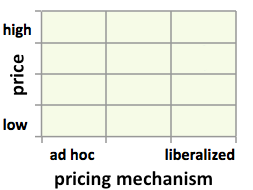Click here to register!
Difference between revisions of "Fuel Prices Cameroon"
***** (***** | *****) |
***** (***** | *****) |
||
| Line 6: | Line 6: | ||
According to Central African Republic newspaper sources, a lot of fuel is smuggled out of Cameroon into the CAR, where fuel prices are ~50 US-cents higher. | According to Central African Republic newspaper sources, a lot of fuel is smuggled out of Cameroon into the CAR, where fuel prices are ~50 US-cents higher. | ||
| + | |||
| + | |||
| + | Automatic fuel price adjustments were suspended after deadly riots with more than 100 deaths in Feb 2008, protesting, amongst others, fuel price increases. Fuel prices were frozen until Dec 2008 when they were lowered, and have not been adjusted since. Government’s policy since 2008 is to compensate the national oil company’s refinery for the difference between the prices set by the formula adopted in 2007 and the administratively fixed prices. Government spent FCFA 146 billion (US$0.3 billion) in 2010 (1.3% of GDP) and FCFA 309 billion (US$0.65 billion) in 2011 (2.5% of GDP) on fuel subsidies, and subsidies in 2012 are expected to reach FCFA 400 billion (US$0.8 billion). Cumulative obligations and arrears to the refinery at the end of 2011 amounted to FCFA 445 billion (US$0.9 billion), or 3.7% of GDP. In Mar 2012, as part of the measure to clear the arrears, government agreed to cancel FCFA 87 billion (US$0.2 billion) worth of taxes due from the refinery in the second half of 2011. Government announced fuel price increases effective Jan 2012, but backed down after threats of a strike. (Source: Kojima, Masami. (2013, forthcoming). “Petroleum product pricing and complementary policies:Experience of 65 developing countries since 2009.” Washington DC: World Bank.) | ||
|Fuel Currency=XAF | |Fuel Currency=XAF | ||
|Fuel Price Exchange Rate=472.88 | |Fuel Price Exchange Rate=472.88 | ||
Revision as of 12:33, 14 February 2013
Part of: GIZ International Fuel Price database
Also see: Cameroon Energy Situation
Fuel Pricing Policies
| Local Currency: | XAF |
| Exchange Rate: | 472.88
|
| Last Update: |
The „Caisse de Stabilisation des Prix des Hydrocarbures“ (CSPH) is in charge of regulating the fuel prices in Cameroon. This fund aims to flatten out strong price jumps. The CSPH does not have any internet appearance as of 2010-12-13 (maybe website is temporarily down).
According to → App. A2, fuel price information is published through communiqués to the public.
According to Central African Republic newspaper sources, a lot of fuel is smuggled out of Cameroon into the CAR, where fuel prices are ~50 US-cents higher.
Automatic fuel price adjustments were suspended after deadly riots with more than 100 deaths in Feb 2008, protesting, amongst others, fuel price increases. Fuel prices were frozen until Dec 2008 when they were lowered, and have not been adjusted since. Government’s policy since 2008 is to compensate the national oil company’s refinery for the difference between the prices set by the formula adopted in 2007 and the administratively fixed prices. Government spent FCFA 146 billion (US$0.3 billion) in 2010 (1.3% of GDP) and FCFA 309 billion (US$0.65 billion) in 2011 (2.5% of GDP) on fuel subsidies, and subsidies in 2012 are expected to reach FCFA 400 billion (US$0.8 billion). Cumulative obligations and arrears to the refinery at the end of 2011 amounted to FCFA 445 billion (US$0.9 billion), or 3.7% of GDP. In Mar 2012, as part of the measure to clear the arrears, government agreed to cancel FCFA 87 billion (US$0.2 billion) worth of taxes due from the refinery in the second half of 2011. Government announced fuel price increases effective Jan 2012, but backed down after threats of a strike. (Source: Kojima, Masami. (2013, forthcoming). “Petroleum product pricing and complementary policies:Experience of 65 developing countries since 2009.” Washington DC: World Bank.)
Fuel Prices and Trends
| Gasoline 95 Octane | Diesel | |
|---|---|---|
| in USD* |
|
|
| in Local Currency |
|
|
* benchmark lines: green=US price; grey=price in Spain; red=price of Crude Oil
Fuel Price Composition
Price composition.
According to →App. A1, there are taxes and subsidies (This Information might be obsolete!).
At a Glance
| Regulation-Price-Matrix |
| ||||
 |

|

|

| ||
CSPH website down or non-existent.
Sources to the Public
Contact
Please find more information on GIZ International Fuel Price Database and http://www.giz.de/fuelprices



















